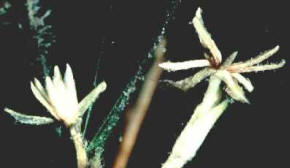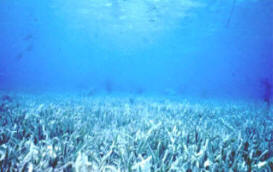 |
|
|
Home | Boating | Fishing | Diving | Water Sports | Boating Safety | Environment | Weather | Photo Blog | Add Your Company to the Directory |
| You Are Here > Home > Marine Environment > Seagrasses |
 Florida Seagrasses Florida SeagrassesThe seagrass beds in Florida's near-shore waters are among the ocean's most productive ecosystems!
What are
Seagrasses? Florida's approximately 2,000,000 acres of seagrasses perform many significant functions:

Florida's
Seagrasses
Ruppia maritima, or widgeon-grass, grows in both fresh and salt
water and is widely distributed throughout Florida' estuaries in the
less saline areas. It has umbrella-like cluster of four to six fruits.
Shoal-grass, Halodule wrightii, is an early colonizer of vegetated
areas and usually grows in water too shallow for other species except
widgeon-grass.
Turtle-grass, Thalassia testudinum, the largest of the Florida
seagrasses, characteristically has deeper root structures than any of
the other seagrasses.
Manatee-grass, Syringodium filiforme, is easily recognizable
because its leaves are cylindrical.
The species of Halophila are star-grass, Halophila engelmannii;
paddle-grass, Halophila decipiens; and Johnson's seagrass,
Halophila johnsonni. These are smaller, more fragile seagrasses. Only
limited information about them exists, although surveys are underway to
define their ecological roles. Johnson's seagrass grows only in the
Indian River Lagoon and is listed as threatened.
|
Scientists of the Fish and Wildlife Conservation commission's Florida Marine Research Institute are using GIS technology to study changes in Florida's coastal fisheries habitats, of which seagrass beds are a major component. By analyzing aerial photographs taken over time, the scientists are able to evaluate habitat change. Along the southwest Florida coast, two major bay systems have similar physical features but dramatically different histories. The Tampa Bay system, which has been highly developed and urbanized, has lost 81% of its seagrass acreage over the past 100 years. Charlotte Harbor, on the other hand, is a less developed estuary. A 29% decrease in its seagrass acreage was documented by comparing aerial photographs from 1944 to 1982. Several sites on the east Florida coast have been analyzed. Among them are Ponce Inlet, just south of Daytona Beach, and the Indian River from Sebastian Inlet south to St. Lucie Inlet. The Ponce Inlet site has lost 100% of its seagrass, principally from dredge-and-fill activities from development of the Intracoastal Waterway. In a seven-mile stretch of estuary surrounding Sebastian Inlet, seagrasses have declined 38% since 1951. Another Indian River study site north of Fort Pierce has lost 25% of its seagrasses since 1958. The studies that document fisheries habitat alterations in Florida are proving helpful to local and state officials. They are increasing public awareness about the problem of fisheries habitat losses and are providing incentives to address this serious problem in Florida's coastal zone. How
You Can Help
Some information and images on this page provided by the Florida Fish & Wildlife Conservation Commission. |
|
Privacy Policy |
Advanced
Search |
Photo Gallery
|
Add Your
Company To The Directory
|
Advertise
|
Contact Us |
